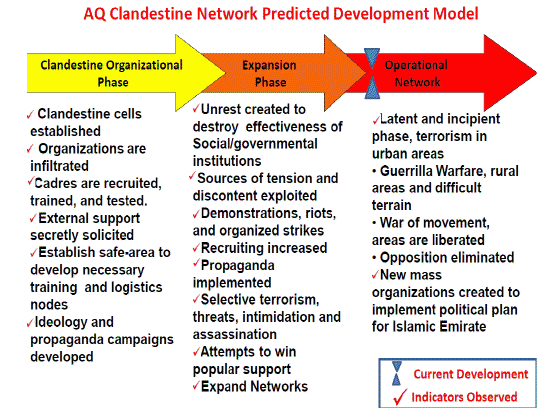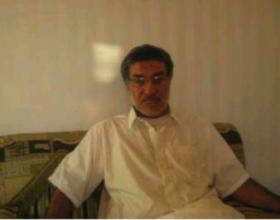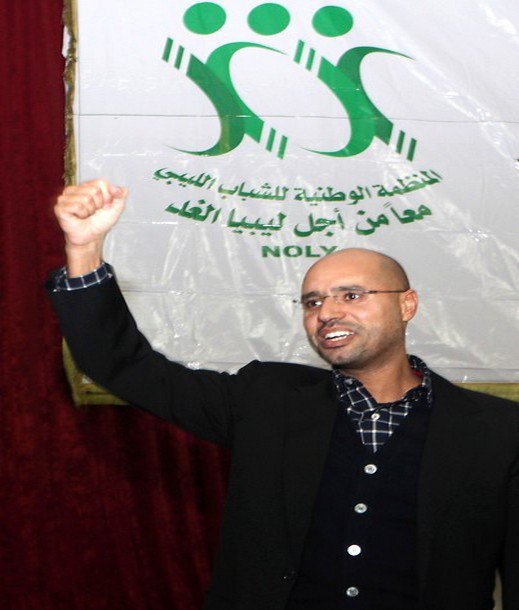Al Qaeda's plan for Libya highlighted in congressional report
منتديات زنقتنا-منتديات شباب ليبيا الأحرار :: المنتديات السياسية :: الأخبار باللغة الانجليزية News in English
صفحة 1 من اصل 1
 Al Qaeda's plan for Libya highlighted in congressional report
Al Qaeda's plan for Libya highlighted in congressional report
By Thomas JoscelynSeptember 21, 2012
An unclassified report published in August highlights al Qaeda's strategy for building a fully operational network in Libya. The report ("Al Qaeda in Libya: A Profile") was prepared by the federal research division of the Library of Congress (LOC) under an agreement with the Defense Department's Combating Terrorism Technical Support Office.
Al Qaeda's senior leadership (AQSL) in Pakistan has overseen the effort. AQSL "issued strategic guidance to followers in Libya and elsewhere to take advantage of the Libyan rebellion," the report reads. AQSL ordered its followers to "gather weapons," "establish training camps," "build a network in secret," "establish an Islamic state," and "institute sharia" law in Libya.
Each part of this strategy is being implemented, and al Qaeda's plan has advanced to the final stages. The three conceptual phases of an al Qaeda affiliate's development are outlined in a chart prepared by the US military and shown here.

"AQSL in Pakistan dispatched trusted senior operatives as emissaries and leaders who could supervise building a network," the report notes. They have been successful in establishing "a core network in Libya," but they still act clandestinely and refrain from using the al Qaeda name.
The report finds that al Qaeda "will likely continue to mask its presence under the umbrella of the Libyan Salafist movement, with which it shares a radical ideology and a general intent to implement sharia in Libya and elsewhere."
Senior terrorists and others involved in effort
Al Qaeda's emir, Ayman al Zawahiri, has overseen the effort to establish a robust presence in Libya. Other senior al Qaeda operatives in Pakistan have also been involved. Abu Yahya al Liba and Atiyah Abd al Rahman, two top al Qaeda operatives who have been killed in drone strikes, helped guide the project prior to their demise. Some al Qaeda operatives have been tasked with taking over, or forming, katibas -- or fighting battalions. Others oversee al Qaeda's project and coordinate with senior leaders operating elsewhere.
The following al Qaeda operatives in Libya, as well as other suspected al Qaeda-affiliated individuals, are identified by name in the report:

Abu Anas is "most likely involved in al Qaeda strategic planning and coordination between AQSL and Libyan Islamist militias who adhere to al Qaeda's ideology." Abu Anas and his fellow al Qaeda operatives "have been conducting consultations with AQSL in Afghanistan and Pakistan about announcing the presence of a branch of the organization that will be led by returnees from Iraq, Yemen, and Afghanistan, and by leading figures from the former LIFG." (The LIFG refers to the Libyan Islamic Fighting Group, an al Qaeda-linked jihadist group formed in Libya in the 1990s.)
The report says that "intense communications" from AQSL in Pakistan are passed through Abu Anas in Libya.
Abd al Baset Azzouz was sent to Libya by Zawahiri and has been close to al Qaeda's leader "since 1980 and first visited Afghanistan in the 1990s to join the mujahedin fight against the Soviet occupation." Azzouz "has been operating at least one training center" and "sent some of his estimated 300 men to Brega to make contact with other militant Islamist groups farther west."
 |
Sufyan ben Qumu. |
Qumu has denied any links to al Qaeda in interviews with the press. However, the authors of "Al Qaeda in Libya" say the Ansar al Sharia battalion led by Qumu "has increasingly embodied al Qaeda's presence in Libya, as indicated by its active social-media propaganda, extremist discourse, and hatred of the West, especially the United States." Qumu has led a campaign of targeted assassinations, including against those opposed to al Qaeda.
Qumu is reportedly suspected of involvement in the attack on the US consulate in Benghazi on Sept. 11, 2012.

Hafiz al-'Aghuri (aka Hayaka Alla) is "a close ally of Wisam Ben Hamid," and co-leader of Katiba Dir' Libya. Sitting in front of an al Qaeda flag, al-'Aghuri recorded a video in which he rebutted the Libyan government's claim that his battalion is insignificant, saying that "Dir' Libya has secured the southeast border with Chad and Egypt without asking anything from the government."

Wisam Ben Hamid "is a young rebel leader who allegedly fought in Iraq." Two brigades, Katiba al-A'hrar Libya and Katiba Dir' Libya, are reportedly under his control and both of them are "involved in postrevolutionary militia fighting in the Qaddafi stronghold Sirt and in Kufra in southeast Libya." Ben Hamid "has been cited as one of the possible leaders of al Qaeda in Libya even though it is unlikely, given his prominence in the media, which contradicts AQSL's usual penchant for secrecy."
Abu Jandal al Libi is described as an al Qaeda "adherent" and "Libyan rebel." Not much is known about Abu Jandal, but he sought guidance from al Qaeda's legal forum. An al Qaeda theorist known as Abou Mouslim al Djazairi responded to Abu Jandal's query, issuing a fatwa that he and his allies should secretly "form an organization bringing together sincere and loyal people" and should split from the Transitional National Council, which has "embroiled itself as well as all Libya in the swamp of servitude to the Crusaders."
Ahmad Abu al Rashid (real name Nauri Husayn) fought in Yemen but has returned to Libya, via Somalia and Sudan. He is described as one of a group of "jihadist Salafists upholding al Qaeda ideology in Libya." Jihadists "such as Abu al Rashid indeed control militias composed of hundreds of people," the report reads. Abu al Rashid is among the "returnees from Afghanistan, Iraq, and Yemen, as well as elements of the former LIFG" who are "preparing to announce their presence after the conclusion of consultations with AQSL."
Ansar al Sharia and the militias
The leaders listed above likely constitute a small fraction of al Qaeda's overall presence in Libya. Citing media reports, the authors of "Al Qaeda in Libya" note that "a few hundred al Qaeda members must currently be operating in Libya." The report continues by observing that "most of them are likely connected with three katibas -- Ansar al-Sharia in Darnah, al-A'hrar Libya in Sirt, and Dir' Libya in Kufra."
These three katibas are just the most conspicuous, however, because of "their radical rhetoric and allegiance to the black flag, which symbolizes the commitment to al Qaeda-type militant jihad."
In addition, the name Ansar al Sharia is used by multiple groups inside Libya. It is not just the name of individual battalions, but also may be al Qaeda's new overall brand in Libya. Ansar al Sharia is being used by al Qaeda in Yemen, Tunisia and elsewhere to rebrand itself as an organization that represents true Islamic law. For example, the emir of al Qaeda in the Arabian Peninsula, Nasir al Wuhayshi, is also the emir of Ansar al Sharia Yemen.
The various Ansar al Sharia branches have their own social media sites, including in some cases Facebook pages. Their digital presences, while containing some differences, are also eerily similar. Much of the content and branding is the same, and they all praise senior al Qaeda leaders.
The three battalions identified in the report as most likely affiliated with al Qaeda are just the "tip of the iceberg." In June 2012, Ansar al Sharia "staged a large-scale rally and military show of force involving dozens of military vehicles, with Islamists wearing the Afghan mujahidin's traditional outfit." The rally included "a parade in which some 30 battalions" from various Libyan towns participated "in the first meeting in support of sharia in Benghazi."
In all, 15 militias attended the Ansar al Sharia rally. It is not clear how many are firmly within al Qaeda's orbit, allied with the group, or otherwise positioned. Even if some of these militias are not staunchly allied with al Qaeda currently, they may cooperate or be co-opted by the group in the future.
"Al Qaeda in Libya" contains graphic evidence that al Qaeda-affiliated battalions have already acquired heavy armaments, including mobile rocket launchers and self-propelled antiaircraft guns. As al Qaeda's clandestine network continues to acquire arms, the group will have more firepower with which it can target any dissenters, as well as the shaky Libyan government.
Al Qaeda is doing its best to destabilize the new post-Qaddafi government, seeing an opening to inculcate its radical ideology and organization during a time of uncertain transition. Al Qaeda is also exploiting tribal and ethnic conflicts, using them to "build alliances and support, especially in the south, where Arab tribes are fighting the Tubu (Tebu) African minority that straddles the Libya-Chad border." One of the al Qaeda-connected battalions, Dir' Libya, is fighting alongside the Arab tribes against the Tubu.
Connections to other al Qaeda franchises
Al Qaeda's growing presence in Libya is not self-contained, but instead part of an international network. Al Qaeda operatives in Libya work with their counterparts in al Qaeda in the Islamic Maghreb (AQIM), a known al Qaeda affiliate, and other parties throughout North Africa and the Middle East.
Al Qaeda's "clandestine network in Libya will probably continue to provide critical support to AQIM," the report reads, "especially with regard to arms procurement and safe passage of militants, which are essential to sustain AQIM's war in northern Mali."
The report's authors warn that Libya "may already have become the favorite destination for would-be jihadists in Syria." Recruits from north Africa and Europe "are increasingly crossing Libya's borders on their way to Syria, probably with the blessing of the current Libyan government." Libya has long been tied to the jihadist network in Syria, as many of the al Qaeda fighters who transited through Syria to fight the US-led coalition in Iraq came from eastern Libya.
Although al Qaeda did not bring the Arab Spring, the terrorist group is seeking to capitalize on it. Al Qaeda "has tried to exploit the 'Arab Awakening' in North Africa for its own purposes during the past year," the report reads.
A clandestine network in Libya is just part of AQSL's plan.
Origenal Link
http://www.longwarjournal.org/archives/2012/09/al_qaedas_plan_for_l.php#ixzz27seC8xgW

Zico-

- الجنس :

عدد المساهمات : 10514
نقاط : 20925
تاريخ التسجيل : 28/05/2011
. :
. :
 مواضيع مماثلة
مواضيع مماثلة» Leaked report: SAS on ground in Libya for months
» CIA moved Libya missiles to Syria rebels: Report
» Pentagon Has Plan to Cripple ISIS in Libya With Air Barrage
» In Libya has it all! There is a lack of entertainment! Libya. The tragedy of the Libyan culture "In Libya has it all! Even democracy! There's just entertainment! "
» Libya: 1 Sept. 2011 - Anniversary - 42 years ago, Col. Muammar Gaddafi has liberated Libya!
» CIA moved Libya missiles to Syria rebels: Report
» Pentagon Has Plan to Cripple ISIS in Libya With Air Barrage
» In Libya has it all! There is a lack of entertainment! Libya. The tragedy of the Libyan culture "In Libya has it all! Even democracy! There's just entertainment! "
» Libya: 1 Sept. 2011 - Anniversary - 42 years ago, Col. Muammar Gaddafi has liberated Libya!
منتديات زنقتنا-منتديات شباب ليبيا الأحرار :: المنتديات السياسية :: الأخبار باللغة الانجليزية News in English
صفحة 1 من اصل 1
صلاحيات هذا المنتدى:
لاتستطيع الرد على المواضيع في هذا المنتدى






» تحية لفرسان لبنان
» أشجان عربية
» فلنحم وجودنا
» وداع الأبطال
» بين الدين والاخلاق
» حول مفهوم الحضارة
» فيم تكمن قيمة الانسان ؟؟؟
» حزب المجد
» نداء الإقدام
» نداء الى امّتنا
» حقيقة الثقافة
» وجعٌ على وجع
» تعاظمت الجراح
» بجلوا الابطال
» موقف عز وشرف
» نداء الوفاق
» رثاء الشهيد اسماعيل هنية
» هدهد الجنوب
» حماة العفن